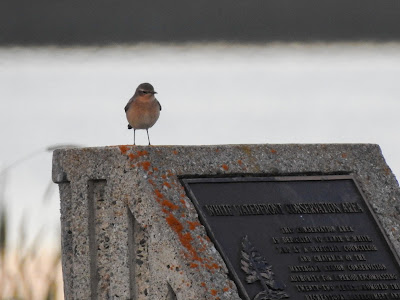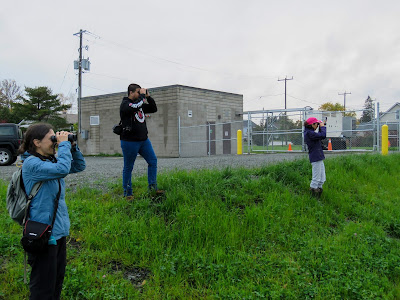A lot has happened since the last time I wrote here in May 2020 when spring migration was still on. Here are a few of the highlights that made 2020 a bit brighter.
| One of the last warblers to migrate through Timmins in spring Blackpoll Warbler - Porcupine Lake (25 May 2020) |
Spring 2020- First Timmins/South Porcupine OFO field trip (cancelled) coincided with Timmins first Bullock's Oriole
Our first Timmins/South Porcupine OFO birding outing was set to take place May 23rd but was understandably cancelled due to Covid-19 provincial guidelines. On that day, as I was birding Porcupine Lake, we got a message from Melanie about an oriole species found at a feeder nearby. The species was difficult to judge from the submitted photo at first but since any oriole species is rare here, I went straight to the location, quickly followed by Pierre; we were astonished to be looking at Timmins' first Bullock Oriole. It was found in a local birders' yard at Nighthawk lake, just a few minutes from South Porcupine, and Melanie saw the post and alerted us immediately. It only stayed one day or 2 and many local birders had a chance to see it (while respecting the distancing guidelines); the homeowners were wonderful and welcoming and the bird would've never been detected if it weren't for their keen eyes.
| Bullock's Oriole in Timmins Nighthawk Lake (23 May 2020) |
| Bullock's Oriole Nighthawk Lake, Timmins (23 May 2020) |
Reviewing and Updating the Timmins Checklist of Birds
| Clay-coloured Sparrow Timmins (June 2020) |
Upcoming Ontario Breeding Bird Atlas (Atlas-3)
The 3rd Ontario Breeding Bird Atlas will be taking place from 2021 to 2025. I am delighted to be one of the Regional Coordinator with Bruce Murphy for Region 41 (Timiskaming) which includes the Timmins, Kirkland Lake and New Liskeard area. The website and registration is now available here: Ontario Breeding Bird Atlas Website. Birders of all levels can participate and contribute. If you would like to know more, don't hesitate to contact me.
Here is a Black-backed Woodpecker nest I discovered in South Porcupine this June.... we'll see if we can discover more for the Ontario Breeding Bird Atlas during the upcoming 5 years.
| Black-backed Woodpecker at nest site South Porcupine (17 June 2020) |
| Black-backed Woodpecker young in nest I love the heart-shaped yellow forehead patch! South Porcupine (17 June 2020) |
| Remaining a respectable distance from any nest is crucial The photos above were taken from this distance with 80X zoom |
Northern Wheatear at Porcupine Lake - Sept 18 to 31
On September 18 before sunset, I checked the weather network and saw that there had been a long overdue north wind that day, so we decided to do a quick check for fall migrants at Porcupine Lake. As soon as I stepped out of the car, before I even got my bins, I saw 2 Black-bellied Plovers as well as another bird perched on a bench further passed the beach. The bird then went down and was walking, a bit 'thrushlike', moving forward in short bursts then standing tall and proud for a while. It went back to catching insects quickly. Then, it would fly up on a nearby perch and it would keep its position for a few second, then lift its tail slightly, then stand there. That's when the alarm bell rang...the period of just "standing still" didn't fit with any other bird that would be a regular occurrence here. An American Pipit would've been more hyperactive, a thrush wouldn't stand on a bench just casually looking sideways. I lifted my bins and saw a small portion of its head sticking from the grass and then I heard the sound of motors coming...
 |
| Northern Wheatear on the White Waterfront C. A. plaque On the evening I found it (18 September 2020) |
At that point, before getting the definite i.d., a dirt bike and a 4-wheeler arrived to my right and were going to trespass illegally in the conservation area right where the bird was! (These motorized vehicles have been doing damage to the trails and the newly planted vegetation at Porcupine Lake and there was no way they were going to flush this bird) I jumped and gestured for them to stop. At first they ignored me but I was very persistent. After I asked (firmly but politely) that they turn around, they did (while complaining). I put my bins on the bird and immediately handed my phone to Gary saying, "open Sibley's, pull up Northern Wheatear, open my messages and open Discord" to which he replied "and what are you going to do while I do all this?" Silly question..."I'm going to watch the bird!"
I alerted everyone I thought of, but the sun was going down. To everyone's delight, it was still there on Saturday morning and it gave many local birders amazing views. As it got colder and windier on Sunday, it spent more time away from the lake and in private backyard where it would forage for insects on lawns and around private gardens. By Monday, it had discovered the fenced in yards and the private decks. It became a tricky situation when it was clear that looking at the bird meant we'd be pointing our binoculars and cameras towards private yards. After a conversation with the homeowners, all of them were very welcoming; in fact, many of them invited visiting birders in their yard to get a better look and even kept their dogs on a leash or inside the house.
The bird stayed for an astonishing 13 days in the same general location, during which 15 local and 28 out of town birders came to see it. My friend Swapnil was instrumental in helping me keep an eye on the bird and relocating it when visitors were due to arrive. 44 birders in 13 days is a lot for the Timmins Area, but a rare bird like this would've attracted more than that number in one day if it had landed in southern Ontario. Porcupine Lake was the best location, as the bird only had 2 to 4 visiting birders at a time and everyone respected physical distancing. I met many great, kind, amazing people during this time; it was fun to chat about birds.
It has been an exciting fall for observing Northern Wheatears. A few more were discovered not long after the Porcupine Lake bird. For a species that is recorded only once every few years, it was surprising.
 |
| Watching the Northern Wheatear - 2 meters apart Me, Swapnil D. and Darlene R. Porcupine Lake (27 Sept 2020) |
What better way to end a long post than with a Gyrfalcon from yesterday. I am very grateful to be living up north.
 |
| Gyrfalcon Timmins (10 October 2020) |
 |
| Gyrfalcon Timmins (10 October 2020) |
Happy Thanksgiving!
